| Article ID | Journal | Published Year | Pages | File Type |
|---|---|---|---|---|
| 2590465 | NeuroToxicology | 2007 | 7 Pages |
The brain is the main target organ for methylmercury (MeHg), a highly toxic compound that bioaccumulates in aquatic systems, leading to high exposure in humans who consume large amounts of fish. The mechanisms responsible for MeHg-induced changes in neuronal function are, however, not yet fully understood. In the present study we investigated whether MeHg-induced elevations in reactive oxygen species (ROS) or intracellular calcium are responsible for altering mitochondrial metabolic function in rat striatal synaptosomes.MeHg decreased mitochondrial function (measured by the conversion of MTT to formazan) and increased ROS levels in striatal synaptosomes after 30 min exposure. Although co-incubation with the antioxidant Trolox significantly reduced MeHg-induced ROS levels, it failed to restore mitochondrial function. MeHg also increased cytosolic and mitochondrial calcium levels in striatal synaptosomes. These elevations were largely independent of extrasynaptosomal calcium, given that nominal calcium-free buffer with 20 μM EGTA did not prevent MeHg-induced increases in cytosolic calcium. In conclusion, we suggest that ROS are not the cause of mitochondrial dysfunction in striatal synaptosomes after MeHg exposure; rather, we propose that ROS formation is a downstream event that reflects MeHg-induced mitochondrial dysfunction due to increased mitochondrial calcium levels.
